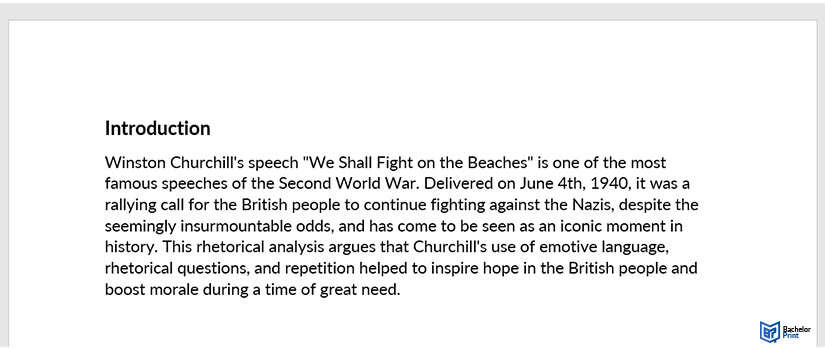
Rhetorical analysis is a cornerstone of academic writing, involving the examination and interpretation of texts to uncover the strategies used by authors to persuade their audiences. In the academic essay, it serves as a powerful tool to decode the underlying mechanisms of argumentation and presentation. Its proficiency in understanding rhetoric can help refine argumentation, support claims, and foster critical thinking.
Definition: Rhetorical analysis
Rhetorical analysis is a form of criticism that evaluates a text, speech, or public statement to understand how the author or speaker attempts to persuade their audience. A rhetorical analysis can be used to understand various texts, from political speeches to advertisements to academic essays.
In rhetorical analysis, it is crucial to avoid making value judgments about the author or their argument. The goal is to understand how they are trying to persuade, not to say whether you agree with them.
The key sections of rhetorical analysis are the:
- Introduction
- Body
- Conclusion
The focus of the rhetorical analysis will vary depending on the text being examined, but it generally involves understanding the context of the argument, identifying the key concepts, and analyzing how the author uses rhetoric to persuade their audience.
The key concepts in rhetorical analysis
Aristotle defined rhetoric as:
“The faculty of discovering in any particular case all of the available means of persuasion.”
In other words, rhetoric is the art of persuasion. When you engage in rhetoric, you use language to persuade your audience to see things your way.
The fundamental concepts of rhetoric
Appeals:
- The different ways you can persuade your audience (logos, pathos, ethos).
Text:
- The work you are analyzing.
Context:
- Details about the creator of the work, the audience, when and where the text was created, and its purpose.
Claims:
- The main points or arguments you make in your rhetoric.
Support:
- The evidence you use to back up your claims.
Warrants:
- The assumptions you make about your audience allow you to connect your support to your claims.
Appeals in rhetorical analysis
Appeals in rhetorical analysis refer to the use of emotions, logic, or credibility to persuade an audience. There are three main types of appeals:
- Logos: An appeal to logic that uses reason and evidence to persuade the audience.
- Pathos: An appeal to emotion that seeks to create an emotional response in the audience.
- Ethos: An appeal to the credibility that aims to establish the speaker’s or writer’s credibility.
| Name | Appeals to | Goal | Strategy | Example |
| Logos | Logic or reason | Persuasion | Evidence and reasoning | Statistics show the UK Consumer Prices Index (CPI) rose by 9.1% in the year to May 2022, so inflation is rising. |
| Pathos | Emotion | Connection | Emotional language or stories | A story about a mother who has to choose between buying food for her family or paying rent. |
| Ethos | Credibility | Persuasion | Relies on the speaker's credibility or expert source | The speaker is a respected and renowned economist with over 20 years of experience.3 |
Claims, support, and warrants
In a rhetorical analysis, claims, support, and warrants establish the arguer’s position on a given issue, and they can be implied rather than stated explicitly.
- A claim is the main argument being made.
- Support is the reasoning or evidence used to back up the claim.
- Warrants are the assumptions that connect the claim and support it.
Understanding text and context
You’ll need to understand the text and its context to conduct an effective rhetorical analysis. The text is the piece of content that you’ll be analyzing, while the context is the background information surrounding the text.
To understand the text, consider who wrote it, its purpose, and the intended audience. Also, think about the genre of the text and any essential rhetorical devices used.
The context includes the historical moment in which the text was written and the social, political, and cultural context surrounding the author. This background information will help you understand the text on a deeper level.
Understanding text and context is vital for your rhetorical analysis because it helps you engage with the material critically. It also allows you to situate the text within a larger discussion and to see how it contributes to the conversation.
The process of rhetorical analysis
When it comes to rhetorical analysis, the main steps in the process are as follows:
1. Determine the purpose of the text
Start by understanding why the author wrote the text and what they were trying to achieve.
To determine the purpose more easily for your rhetorical analysis, ask yourself questions such as:
- Who wrote the text?
- What is the genre of the text?
- When was the text written?
- What are the circumstances of the text?
2. Understand the context
To understand the context, consider factors such as the historical moment in which it was written and the social, political, and cultural context surrounding the author.
You can ask questions such as:
- What was happening in the world at the time the text was written?
- What were the social, political, and cultural circumstances of the author?
3. Identify the claims, support, and warrants
The claims, support, and warrants are the key components of an argument, and understanding them is essential to your rhetorical analysis.
To identify them more easily, ask yourself questions such as:
- What is the author trying to argue?
- What evidence do they use to support their argument?
- How does the evidence support the claim?
4. Analyze the rhetoric of the text
This step involves understanding how the author uses language to persuade their audience.
To analyze the rhetoric, consider questions such as:
- What tone does the author use?
- What level of formality does the author use?
- What kind of language does the author use?
5. Draw conclusions
Next, draw conclusions about the text based on your rhetorical analysis. This involves considering the overall effectiveness of the text and determining whether the author achieved their purpose.
Ask yourself questions such as:
- Was the author successful in achieving their purpose?
- What could they have done differently to be more successful?
- What do you think about the text?
6. Write your analysis
Finally, write your rhetorical analysis. This will involve synthesizing your thoughts on the text and presenting your conclusions in a clear and concise manner.
Be sure to support your claims with evidence from the text.
Rhetorical analysis: Introduction
The introduction of a rhetorical analysis essay is similar to other essays and should explain what text is being discussed, provide relevant context, and introduce your thesis statement.
An example of a rhetorical analysis introduction:

Rhetorical analysis: Body
The body section of your rhetorical analysis will explain how the author uses rhetoric to achieve their purpose. Each paragraph should focus on a different aspect of the text, such as the author’s use of repetition or their choice of words.
Be sure to support your claims with evidence from the text and explain how this evidence supports your claim.
Paragraphs in the body of a rhetorical analysis should be structured as follows:
- Topic sentence: Introduces the main point of the paragraph and explains how it relates to the thesis statement
- Evidence: Provides evidence from the text that supports your claim
- Analysis: Your explanation of how the evidence supports your claim and why it is effective
- Concluding sentence: Wraps up the paragraph and may introduce the next.

Rhetorical analysis: Conclusion
The concluding section of your rhetorical analysis should restate your main argument and whether the text achieved its purpose. You may also want to consider the broader implications of the text and its place in history.
Also, you might want to guide readers on what they can do with this information.

- ✓ Free express delivery
- ✓ Individual embossing
- ✓ Selection of high-quality bindings
FAQs
The goal of rhetorical analysis is to look at a non-fiction work to determine how the material tries to influence the audience.
It focuses on what tools and techniques the author uses to get their point across, and not on the validity of the argument.
The rhetorical analysis focuses on how a text is written, while the literary analysis looks at the meaning of the text.
For example, the literary analysis might examine the use of symbols in a book, while the rhetorical analysis would look at how the author uses language to convey their message.
To conduct a rhetorical analysis, follow theses steps:
- Start by identifying the author’s purpose for writing the piece.
- Next, analyze how the author uses logic, emotion, and credibility to appeal to the audience.
- Finally, determine how effective the author’s techniques are at persuading the audience.
Some techniques used in rhetoric include the appeal to logic (logos), the appeal to emotion (pathos), and the appeal to credibility (ethos).
The author may also use rhetorical questions, metaphors, and repetition to make their point.
